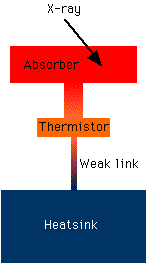 Introduction
Introduction
 We are in the business of measuring the
energy of X-rays from astromomical objects (why?), and we do that with microcalorimeters.
A microcalorimeter, as shown to the left, works by measuring the energy of
an X-ray.
We are in the business of measuring the
energy of X-rays from astromomical objects (why?), and we do that with microcalorimeters.
A microcalorimeter, as shown to the left, works by measuring the energy of
an X-ray.
An X-ray photon is absorbed by the detector, causing it to heat up. We measure this heat with a temperature-sensitive resistor (known as a thermistor). The absorber is partially isolated from the thermistor, so that the absorber temperature can stabilize before the thermistor temperature starts to rise. (Why is that necessary?)
The heatsink is kept at a constant temperature. Once the thermistor heats up to the temperature of the absorber, it begins to (more slowly) cool down to the temperature of the heatsink. After a few milliseconds the thermistor has returned to the heatsink temperature, and is ready to detect another X-ray photon.
Find out more about X-ray astronomy
Find out more about microcalorimeters
Read our Physics Today article
|
This page written and maintained by
Kevin R. Boyce
(email: Kevin.R.Boyce@gsfc.nasa.gov)
This page was last modified on Friday, 10-Oct-2014 14:10:35 EDT